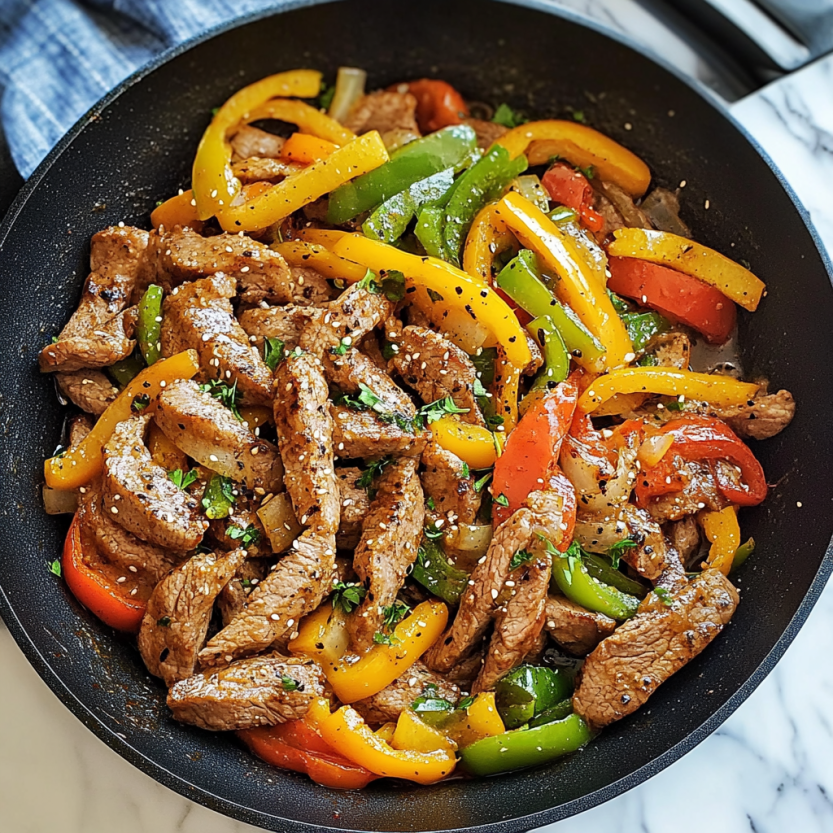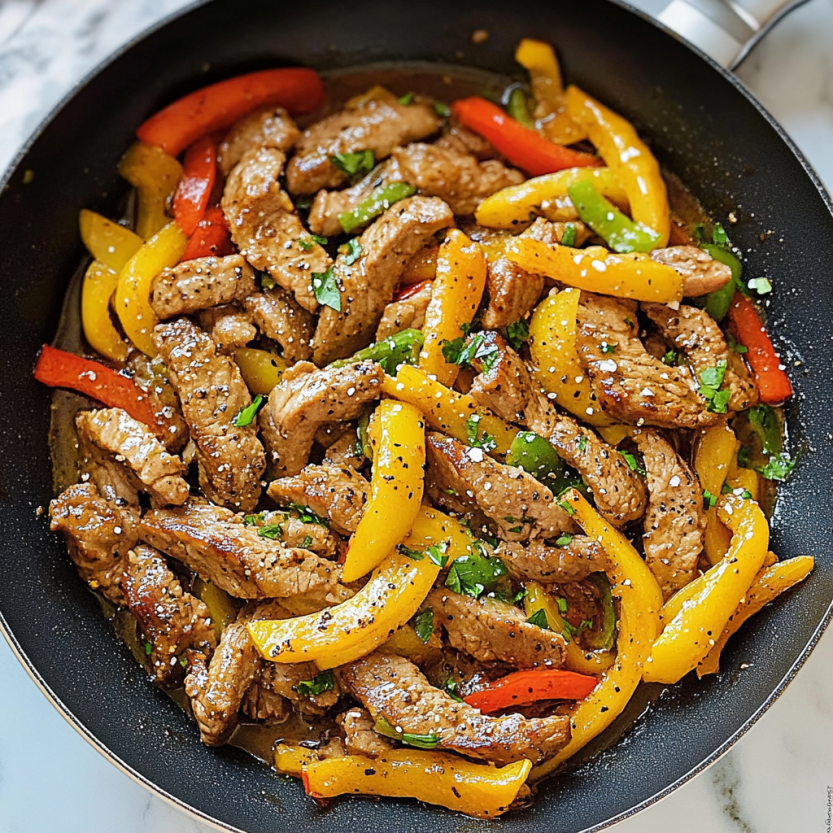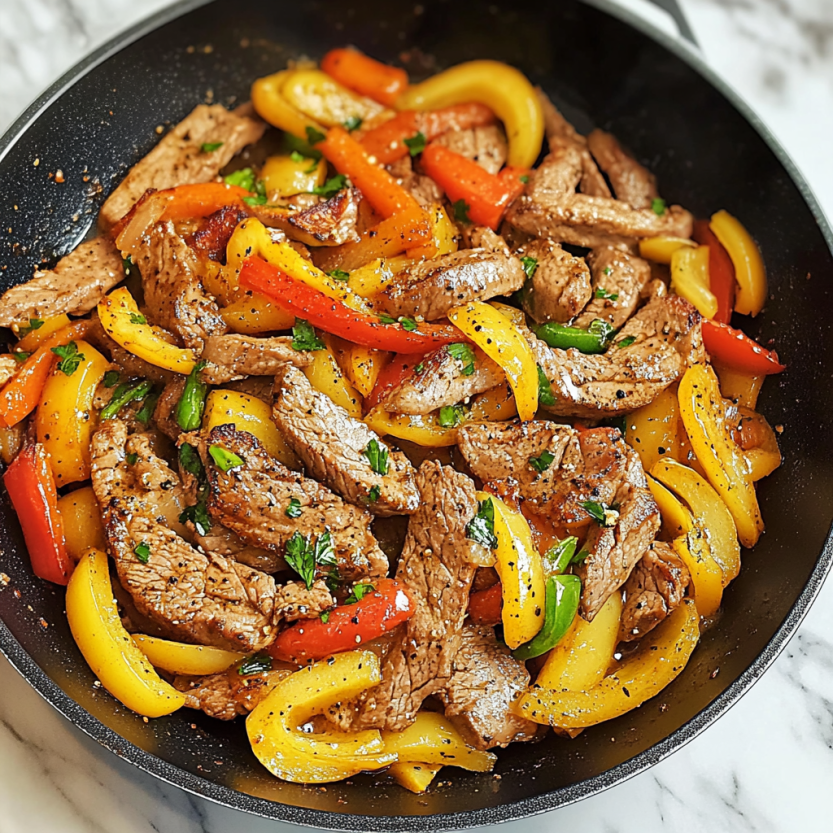 Save
Save
This 15-minute skillet pepper steak has become my secret weapon for those nights when I need a delicious dinner but have zero energy for complicated cooking. Inspired by classic Chinese-American takeout but streamlined for weeknight ease, this colorful dish delivers big flavor with minimal effort.
I first made this recipe during a particularly chaotic Tuesday when my usual meal plan fell apart. My family was so impressed by how quickly it came together that it's now our go-to solution whenever we're craving something satisfying but short on time.
Ingredients
- Top round beef: Thin sliced for quick cooking and tender results
- Kosher salt and fresh black pepper: Essential for properly seasoning the meat
- Peanut oil: Provides high heat tolerance and subtle nutty flavor
- Soy sauce: Adds umami depth and savory richness
- Rice wine vinegar: Balances with bright acidity
- Crushed red pepper flakes: Brings customizable heat
- Bell peppers: In multiple colors create visual appeal and sweet flavor
- Fresh garlic cloves: For aromatic punch and depth
- Scallions: Add fresh onion notes and beautiful garnish
- Sesame seeds: Provide nutty crunch and visual appeal
Step-by-Step Instructions
- Season and Sear the Beef:
- Season your thinly sliced beef generously with salt and pepper. Heat your skillet over medium-high heat with a tablespoon of peanut oil until it shimmers. Add the steak pieces without overcrowding and allow them to quickly brown for about 2 minutes. The goal here is color not complete cooking as they'll finish later.
- Create the Flavor Base:
- Transfer your partially cooked steak to a bowl and immediately toss with soy sauce, rice wine vinegar, and red pepper flakes. This brief marination while you cook the vegetables infuses the meat with flavor and creates the foundation of your sauce.
- Cook the Colorful Peppers:
- In the same flavor-rich skillet add your remaining tablespoon of oil over medium heat. Spread your rainbow of sliced peppers in an even layer allowing them to make good contact with the hot surface. Cook for about 4 minutes tossing occasionally until they begin to soften but still maintain some crispness.
- Combine and Finish Cooking:
- Push your peppers to one side of the pan creating space to return your beef and its flavorful juices to the skillet. Allow the beef to continue cooking for 2 minutes reaching perfect doneness. Add minced garlic to the pepper side and cook for a final minute letting the garlic become aromatic without burning.
- Garnish and Serve:
- Sprinkle your finished dish with sliced scallions and sesame seeds which add freshness contrasting texture and visual appeal. Serve immediately while everything is hot and at its flavor peak.
 Save
Save
This dish reminds me of my first apartment when I was learning to cook on a budget. The way the colorful peppers brighten both the plate and the flavor completely transformed my understanding of simple cooking. Now whenever I make it my kitchen fills with that distinctive savory aroma that signals comfort food is minutes away.
Make It Your Own
The beauty of this recipe is its flexibility. While the original calls for four colors of bell peppers, you can easily use just one or two varieties based on what you have available. Red and orange peppers tend to be sweeter, while green offers a slightly more herbaceous flavor. You can also substitute snow peas, broccoli florets, or sliced mushrooms for some of the peppers to create your own version.
Storage and Leftovers
This pepper steak stores beautifully in airtight containers in the refrigerator for up to three days. The flavors actually deepen overnight making it an excellent meal prep option. I find it reheats best in a skillet over medium heat rather than microwave to maintain the vegetables' texture. For a complete packed lunch, store with a side of steamed rice in a separate container.
Serving Suggestions
While delicious on its own, this pepper steak naturally pairs with steamed rice to soak up the savory sauce. For a lower-carb option, serve over cauliflower rice or alongside roasted sweet potatoes. To complete your homemade takeout experience, consider adding a simple cucumber salad dressed with rice vinegar and a touch of sugar for contrast.
 Save
Save
Recipe Questions
- → What cut of beef works best for this skillet pepper steak?
Top round beef is specified in this recipe because it's lean yet becomes tender when sliced thinly and cooked quickly. You could substitute flank steak, sirloin, or ribeye if preferred. The key is slicing the meat very thin, ideally against the grain, to ensure tenderness in the short cooking time.
- → Can I use fewer varieties of bell peppers?
Absolutely! While the recipe calls for red, yellow, green, and orange bell peppers for color variety, you can use any combination available. Even using just one or two colors will work perfectly fine for the flavor profile. The total amount should be about 4 bell peppers regardless of color.
- → Is there a substitute for rice wine vinegar?
If you don't have rice wine vinegar, you can substitute with apple cider vinegar, white wine vinegar, or even lemon juice in a pinch. Each will provide the necessary acidity, though with slightly different flavor notes. For the closest match, use white wine vinegar with a pinch of sugar.
- → How can I make this dish more filling?
To make this a more substantial meal, serve it over steamed white or brown rice, quinoa, or cauliflower rice for a lower-carb option. You could also add more vegetables like sliced mushrooms, snow peas, or broccoli florets to increase the volume without significantly affecting the calorie count.
- → Can I prepare any components ahead of time?
Yes! To make weeknight cooking even faster, you can slice the beef and peppers up to a day in advance and store them separately in airtight containers in the refrigerator. You can also mince the garlic and slice the scallions ahead of time. The actual cooking should be done just before serving for the best texture and flavor.
- → How spicy is this dish, and can I adjust the heat level?
With 1½ teaspoons of crushed red pepper flakes, this dish has a moderate level of heat. You can easily adjust the spiciness by reducing the amount to ½ teaspoon for a milder version or increasing it to 2-3 teaspoons if you prefer more heat. You could also substitute with sriracha or sambal oelek for a different spice profile.